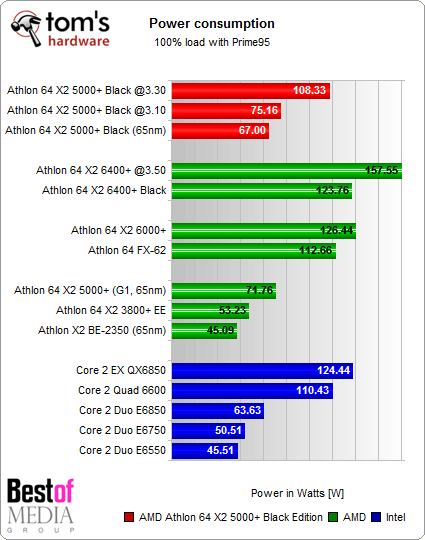AMD's Athlon 64 X2 5000+ Black Edition
Only 75 Watts At 3.10 GHz
Since the processor is made on a 65 nm production process and uses the G2 stepping, it has a thermal design power (TDP) of only 65 W. We compared the thermal dissipation of all currently available AMD and Intel processors, and made a very pleasant discovery when we looked at the results of our overclocked 5000+ Black edition.
When we overclock our 5000+ Black Edition by 500 MHz (29 %) to 3.10 GHz, we see that the power consumption increases only minimally. Due to the fact that the CPU runs at its stock voltage, it only draws 8 W more than it would at stock speed. However, when we set the CPU to run at 3.30 GHz, which requires an increase in core voltage, the thermal power dissipation suddenly jumped to 108 W.
Thanks to its low power dissipation, even older coolers can be used with this CPU.
Due to its older 90 nm production process, the results of the Black Edition 6400+ are much worse.
Another thing that struck us was that the 5000+ Black Edition draws about 4.7 W less power than the normal 5000+, which is also made on a 65 nm process. This is proof that the stepping update from G1 to G2 brings some energy savings with it.
Compared to Intel's Core 2 Duo processors, all of AMD's CPUs currently look bad where energy consumption is concerned. At 3.10 GHz, the 5000+ Black Edition is about as fast as the E6550 while drawing 30 W more power. On the other hand, while the AMD processor consumes 47% more energy, it also costs $40 less, and price usually takes precedence over power consumption when users are looking to upgrade.
Get Tom's Hardware's best news and in-depth reviews, straight to your inbox.
Current page: Only 75 Watts At 3.10 GHz
Prev Page End Of The Line At 3.40 GHz Next Page Performance Boost Of Up To 18.5 %Tom's Hardware is the leading destination for hardcore computer enthusiasts. We cover everything from processors to 3D printers, single-board computers, SSDs and high-end gaming rigs, empowering readers to make the most of the tech they love, keep up on the latest developments and buy the right gear. Our staff has more than 100 years of combined experience covering news, solving tech problems and reviewing components and systems.
-
gowens what kind of cooling system is needed to overclock to 3.1 Ghz? I'm buying a barebones kit with this CPU but no heatsink/fan.Reply -
Cursedeyes this article is very helpful, but my bios lets me increase the cpu voltage in increments of 5 mV up to 600mV . so how much to i out it up in order to equal 1.450 V?Reply -
Koshi This article was helpful in making my decision to buy this processor, but I have a problem when overclocking it (first time overclocking). My pheonix award bios on my m2n sli board wont let me increase the cpu voltage past 1.325, and I want to know if there's anyway I can increase it. I can only get to 14.5x multiplier at this voltage.Reply -
Hi,Reply
Great article. I am new to OC, and have the 5000+ Black Edition and I am running it in an Asus M2N-SLI with a Zerotherm Butterfly CPU cooler. CPU according to HWMonitor, Core 0 is running at about 18C and Core 2 is at about 19 so heat shouldn't be a problem. Memory currently is Patriot 1GB PC2 5300 667mhz but in a couple days I will be adding 4 GB of OCZ SLI Ready Edition Dual Channel DDR2 800 Mhz . My question, is will the 667 Patriot memory that I currently have work if I overclock to 3.0, and would the OCZ 800 be adequate to OC to 3.2 ?
Second, I've not done this before, from what I can gather here I can just change the multiplier in BIOS without messing with voltages if I don't go beyond 3.1 which would be achived by using a 15.5 multiplier.
Thanks for the information here and any tips...
**agroberts@knology.net** -
hellspawnpr I have this CPU , been very happy with it so far. I have it at 3.2ghz running smoothly. I put a gigabyte GIGABYTE GH-PDU22-SC EVR Sleeve CPU Cooler only cost 23.00 has my cpu at 32c idleReply -
Skiscola I can only get mine to a 14.5 multiplier I have a M2N-SLI Deluxe MOBO,CORSAIR XMS2 2GB (2 x 1GB) 240-Pin DDR2 SDRAM DDR2 800 (PC2 6400) Dual Channel Kit Desktop Memory X2 for 4 GB, Thermaltake CL-P0075 80mm 2 Ball CPU Cooling Fan/Heatsink. How can i get it higher without it crashingReply -
Darkerson And to think i passed this one up for a 5200+, for some god awful reasoning at the time. Ah, the good old days!Reply


